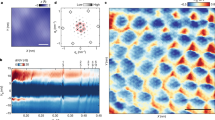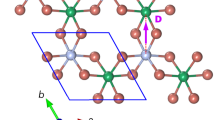Abstract
The coherent tunnelling of Cooper pairs across Josephson junctions (JJs) generates a nonlinear inductance that is used extensively in quantum information processors based on superconducting circuits, from setting qubit transition frequencies1 and interqubit coupling strengths2 to the gain of parametric amplifiers3 for quantum-limited readout. The inductance is either set by tailoring the metal oxide dimensions of single JJs, or magnetically tuned by parallelizing multiple JJs in superconducting quantum interference devices with local current-biased flux lines. JJs based on superconductor–semiconductor hybrids represent a tantalizing all-electric alternative. The gatemon is a recently developed transmon variant that employs locally gated nanowire superconductor–semiconductor JJs for qubit control4,5. Here we go beyond proof-of-concept and demonstrate that semiconducting channels etched from a wafer-scale two-dimensional electron gas (2DEG) are a suitable platform for building a scalable gatemon-based quantum computer. We show that 2DEG gatemons meet the requirements6 by performing voltage-controlled single qubit rotations and two-qubit swap operations. We measure qubit coherence times up to ~2 μs, limited by dielectric loss in the 2DEG substrate.
This is a preview of subscription content, access via your institution
Access options
Access Nature and 54 other Nature Portfolio journals
Get Nature+, our best-value online-access subscription
$29.99 / 30 days
cancel any time
Subscribe to this journal
Receive 12 print issues and online access
$259.00 per year
only $21.58 per issue
Buy this article
- Purchase on Springer Link
- Instant access to full article PDF
Prices may be subject to local taxes which are calculated during checkout




Similar content being viewed by others
References
Koch, J. et al. Charge-insensitive qubit design derived from the Cooper pair box. Phys. Rev. A. 76, 042319 (2007).
Chen, Y. et al. Qubit architecture with high coherence and fast tunable coupling. Phys. Rev. Lett. 113, 220502 (2014).
Castellanos-Beltran, M. A. & Lehnert, K. W. Widely tunable parametric amplifier based on a superconducting quantum interference device array resonator. Appl. Phys. Lett. 91, 083509 (2007).
Larsen, T. W. et al. A semiconductor nanowire-based superconducting qubit. Phys. Rev. Lett. 115, 127001 (2015).
de Lange, G. et al. Realization of microwave quantum circuits using hybrid superconducting–semiconducting nanowire Josephson elements. Phys. Rev. Lett. 115, 127002 (2015).
Vincenzo, D. The physical implementation of quantum computation. Preprint at https://arxiv.org/abs/quant-ph/0002077 (2000).
Clarke, J. & Wilhelm, F. K. Superconducting quantum bits. Nature 453, 1031–1042 (2008).
Sheldon, S., Magesan, E., Chow, J. M. & Gambetta, J. M. Procedure for systematically tuning up cross-talk in the cross-resonance gate. Phys. Rev. A. 93, 060302 (2016).
Hutchings, M. D. et al. Tunable superconducting qubits with flux-independent coherence. Phys. Rev. Appl 8, 044003 (2017).
Kelly, J. et al. State preservation by repetitive error detection in a superconducting quantum circuit. Nature 519, 66–69 (2015).
Neill, C. et al. A blueprint for demonstrating quantum supremacy with superconducting qubits. Science 360, 195–199 (2018).
Rosenberg, D. et al. 3D integrated superconducting qubits. Quantum Inf. 3, 42 (2017).
Kjaergaard, M. et al. Transparent semiconductor–superconductor interface and induced gap in an epitaxial heterostructure Josephson junction. Phys. Rev. Appl. 7, 034029 (2017).
Luthi, F. et al. Evolution of nanowire transmons and their quantum coherence in magnetic field. Phys. Rev. Lett. 120, 100502 (2018).
Casparis, L. et al. Gatemon benchmarking and two-qubit operations. Phys. Rev. Lett. 116, 150505 (2016).
Shabani, J. et al. Two-dimensional epitaxial superconductor–semiconductor heterostructures: a platform for topological superconducting networks. Phys. Rev. B 93, 155402 (2016).
Kringhøj, A. et al. Anharmonicity of a superconducting qubit with a few-mode Josephson junction. Phys. Rev. B 97, 060508 (2018).
Abay, S. High critical-current superconductor-InAs nanowire–superconductor junctions. Nano. Lett. 12, 5622 (2012).
Wallraff, A. et al. Strong coupling of a single photon to a superconducting qubit using circuit quantum electrodynamics. Nature 431, 162–167 (2004).
O’Malley, P. J. J. et al. Qubit metrology of ultralow phase noise using randomized benchmarking. Phys. Rev. Appl. 3, 044009 (2015).
Bylander, J. et al. Noise spectroscopy through dynamical decoupling with a superconducting flux qubit. Nat. Phys. 7, 565–570 (2011).
Barends, R. et al. Coherent Josephson qubit suitable for scalable quantum integrated circuits. Phys. Rev. Lett. 111, 080502 (2013).
Krupka, J., Hartnett, J. G. & Piersa, M. Permittivity and microwave absorption of semi-insulating InP at microwave frequencies. Appl. Phys. Lett. 98, 112112 (2011).
Frey, T. S. Interaction between Quantum Dots and Superconducting Microwave Resonators. PhD thesis, ETH Zurich (2013).
Bruno, A. et al. Reducing intrinsic loss in superconducting resonators by surface treatment and deep etching of silicon substrates. Appl. Phys. Lett. 106, 182601 (2015).
Dial, O. E. et al. Charge noise spectroscopy using coherent exchange oscillations in a singlet–triplet qubit. Phys. Rev. Lett. 110, 146804 (2013).
Rol, M. A. et al. Restless tuneup of high-fidelity qubit gates. Phys. Rev. Appl. 7, 041001 (2017).
Majer, J. et al. Coupling superconducting qubits via a cavity bus. Nature 449, 443–447 (2007).
Hofheinz, M. et al. Synthesizing arbitrary quantum states in a superconducting resonator. Nature 459, 546–549 (2009).
Casparis, L. et al. Voltage-controlled superconducting quantum bus. Preprint at https://arxiv.org/abs/1802.01327 (2018).
Cassidy, M. C. et al. Demonstration of an a.c. Josephson junction laser. Science 355, 939–942 (2017).
Versluis, R. et al. Scalable quantum circuit and control for a superconducting surface code. Phys. Rev. Appl. 8, 034021 (2017).
Ward, D. R., Savage, D. E., Lagally, M. G., Coppersmith, S. N. & Eriksson, M. A. Integration of on-chip field-effect transistor switches with dopantless Si/SiGe quantum dots for high-throughput testing. Appl. Phys. Lett. 102, 213107 (2013).
Al-Taie, H. et al. Cryogenic on-chip multiplexer for the study of quantum transport in 256 split-gate devices. Appl. Phys. Lett. 102, 243102 (2013).
Hornibrook, J. M. et al. Cryogenic control architecture for large-scale quantum computing. Phys. Rev. Appl. 3, 024010 (2015).
Macklin, C. et al. A near-quantum-limited Josephson traveling-wave parametric amplifier. Science 350, 307–310 (2015).
Acknowledgements
We acknowledge helpful discussions with A. C. C. Drachmann, H. J. Suominen, E. C. T. O’Farrell, A. Fornieri, A. M. Whiticar and F. Nichele. This work was supported by Microsoft Project Q, the US Army Research Office, the Innovation Fund Denmark and the Danish National Research Foundation. C.M.M. acknowledges support from the Villum Foundation. M.R.C. received funding from the European Union’s Horizon 2020 research and innovation programme under the Marie Sklodowska-Curie grant agreement No. 750777, and EPSRC (EP/L020963/1). M.K. acknowledges support from the Carlsberg Foundation. N.J.P. acknowledges support from the Swiss National Science Foundation and NCCR QSIT. The travelling wave parametric amplifier used in this experiment was provided by MIT Lincoln Laboratory and Irfan Siddiqi Quantum Consulting (ISQC), LLC, via sponsorship from the US Government.
Author information
Authors and Affiliations
Contributions
T.W., C.T., S.G., G.C.G. and M.J.M. grew the proximitized 2DEG. M.K., L.C., C.M.M. and K.D.P designed the experiment. L.C., M.R.C., A.K., N.J.P., T.W.L., and K.D.P. prepared the experimental set-up. L.C. and M.R.C. fabricated the devices and performed the experiment. L.C., M.R.C., M.K., A.K., T.W.L., F.K., C.M.M. and K.D.P. analysed the data and prepared the manuscript.
Corresponding author
Ethics declarations
Competing interests
The authors declare no competing interests.
Additional information
Publisher’s note: Springer Nature remains neutral with regard to jurisdictional claims in published maps and institutional affiliations.
Rights and permissions
About this article
Cite this article
Casparis, L., Connolly, M.R., Kjaergaard, M. et al. Superconducting gatemon qubit based on a proximitized two-dimensional electron gas. Nature Nanotech 13, 915–919 (2018). https://doi.org/10.1038/s41565-018-0207-y
Received:
Accepted:
Published:
Issue Date:
DOI: https://doi.org/10.1038/s41565-018-0207-y
This article is cited by
-
Parity-conserving Cooper-pair transport and ideal superconducting diode in planar germanium
Nature Communications (2024)
-
Charge-4e supercurrent in a two-dimensional InAs-Al superconductor-semiconductor heterostructure
Communications Physics (2024)
-
Hard superconducting gap in germanium
Communications Materials (2023)
-
Microwave-induced conductance replicas in hybrid Josephson junctions without Floquet—Andreev states
Nature Communications (2023)
-
A gate-tunable graphene Josephson parametric amplifier
Nature Nanotechnology (2022)



